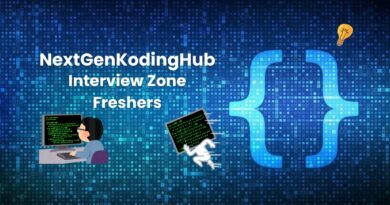Python Interview Questions Advanced
Interview Zone: Advanced Python Interview Prep
30+ Advanced Python Interview Questions
Preparing for advanced Python interview questions can significantly boost your technical confidence. These questions dive into language internals, design patterns, advanced data handling, performance tricks, and debugging techniques. Therefore, this guide collects 30+ well‑crafted advanced Python interview questions that help freshers shine. Each one includes clear explanations, code snippets, and best-practice advice.
Moreover, mastering these advanced Python interview questions demonstrates both breadth and depth of knowledge. You’ll practice nuanced syntax, leverage Python’s standard library, and compare approaches. Altogether, this preparation enables you to respond confidently in real interviews. Let’s explore the questions in detail.
1. What is the Global Interpreter Lock (GIL)?
The GIL is a mutex that protects access to Python objects, allowing only one native thread to execute Python bytecode at a time. Consequently, Python threads don’t run CPU‑bound code in parallel. However, they do work well for I/O‑bound tasks. To achieve true parallelism, you can use the multiprocessing module, which operates multiple processes.
2. Explain Python’s memory management and garbage collection.
Python uses reference counting and a cyclic garbage collector. References increase and decrease as objects are used and released. Then, the GC frees objects in circular references by identifying unreachable groups. Tools like gc and tracemalloc help you debug memory leaks.
3. How do @decorators work under the hood?
Decorators wrap a function object, returning a new callable. They take a function as input and return a wrapped version. Using the @ syntax applies the wrapper at definition time. You can stack multiple decorators or use functools.wraps to preserve metadata.
4. What is the difference between deep copy and shallow copy?
A shallow copy duplicates only top‑level objects; nested objects still reference the original. A deep copy duplicates nested objects recursively. The copy module provides both. Use shallow copy for performance and deep copy when you need fully independent objects.
5. Explain list comprehensions vs generator expressions.
List comprehensions build the full list in memory, whereas generator expressions produce items lazily. Consequently, generators save memory and avoid overhead. Example:
|
1 2 |
lst = [x*x for x in range(1000)] gen = (x*x for x in range(1000)) |
6. Describe tuple immutability and namedtuple use-cases.
Tuples are immutable. Thus, they’re safe hash keys. Use namedtuple or dataclass(frozen=True) for immutability with named attributes. That improves readability and safety.
7. How do you use **args and **kwargs?
Using *args captures positional arguments as tuples. **kwargs captures keyword args as dict. They add flexibility and help build wrappers or adapter functions.
8. Explain context managers and __enter__/__exit__.
Context managers handle setup and teardown automatically. With with open(..), Python calls __enter__ then __exit__. You can implement them manually or use contextlib.contextmanager.
9. When would you use a metaclass?
Metaclasses customize class creation. Use them for auto-registration, input validation or enforcing class patterns. They run at definition time.
10. How does method resolution order (MRO) work?
Python uses C3 linearization to resolve MRO. Use Class.mro() to inspect order. In diamond inheritance, MRO ensures consistency and helps avoid ambiguity.
11. Describe duck typing.
Duck typing focuses on object behavior, not type. “If it quacks like a duck, we treat it as a duck.” You rely on available methods rather than explicit inheritance.
12. What are closures?
Closures capture enclosing scope variables even after the outer function completes. Example:
|
1 2 3 4 5 6 7 |
def make_counter(): cnt = 0 def inc(): nonlocal cnt cnt += 1 return cnt return inc |
13. How do you create a property?
Use @property decorator for getter, plus @x.setter for setter. It provides controlled attribute access with encapsulation.
14. Explain async/await and event loops.
The asyncio module uses coroutines and await on awaitables. The event loop executes them non-blockingly. It excels at high-concurrency I/O workloads.
15. Compare multithreading vs multiprocessing.
Threads share memory but are limited by the GIL. Processes use separate memory spaces but allow true parallelism. Choose threads for I/O and processes for CPU-bound workloads.
16. How can you optimize performance?
Profile using cProfile. Then optimize heavy functions with built-in modules, list/set comprehensions, or rewrites in Cython or C.
17. Explain __slots__.
Slots restrict runtime attribute creation and reduce memory consumption significantly. Use them in high-performance or memory-tight applications.
18. Describe memory profiling tools.
Use tracemalloc for memory tracking, and memory_profiler for line-by-line usage. Use weakref to avoid reference cycles.
19. What is the difference between map/filter and comprehensions?
Map and filter apply functions lazily using itertools. Comprehensions are syntactic sugar, more readable, but less lazy unless wrapped in a generator.
20. How do you memoize in Python?
Use functools.lru_cache to cache expensive function calls automatically. Example:
|
1 2 |
@lru_cache(maxsize=None) def fib(n): return n if n < 2 else fib(n-1)+fib(n-2) |
21. Explain pickling and its limitations.
Pickle serializes Python objects. However, it’s insecure for untrusted data, limited to Python, and doesn’t handle open file objects or sockets.
22. How do you debug in Python?
Use IDE debuggers, logging, pdb, or ipdb. Logging provides insights without breakpoints. Choose tools based on context.
23. What is TDD and how you apply it?
Test‑Driven Development means writing tests first, then production code. Use frameworks like unittest or pytest. It leads to cleaner, maintainable code.
24. Explain hygiene in async programming.
Ensure coroutines always await results, handle exceptions, and close connections. Otherwise unhandled exceptions or silent leaks occur.
25. How do you profile CPU performance?
Use cProfile or pyinstrument to locate performance bottlenecks by function call graphs. Optimize based on profiler data.
26. What are Python’s built-in concurrency modules?
Python provides threading, multiprocessing, asyncio, and concurrent.futures. Each suits different concurrency needs.
27. Explain garbage collection tuning with gc.set_threshold()
You can tune GC thresholds to reduce collection frequency or delay collections for performance tuning in long‑running programs.
28. How do you handle exceptions best?
Use specific exceptions, avoid bare except blocks, clean up in finally or context managers, and log details for debugging.
29. How does Python’s import system work?
Python searches paths in sys.path. __init__.py indicates packages. Caching occurs in sys.modules. Understand module load order and relative imports to avoid conflicts.
30. What are dataclasses and how do they simplify code?
Dataclasses simplify class creation with auto-generated methods. You use @dataclass to define classes concisely and optionally mark them frozen.
Bonus Question: What is coroutine cancellation?
You cancel tasks with task.cancel(). The coroutine gets asyncio.CancelledError. You should catch this to perform cleanup.
Final Thoughts
These advanced Python interview questions offer deep insights into language design, performance, concurrency, and code architecture. Therefore, practicing them with code examples and explaining your thought process will help you leave a strong impression. Furthermore, always deepen your understanding by experimenting with real code, testing edge cases, and exploring alternative implementations. With this preparation, you’ll confidently ace your Python interviews and demonstrate professional-ready skills.



